Charles E W Bean, Diaries, AWM38 3DRL 606/251/1 - 1915 - 1936 - Part 11
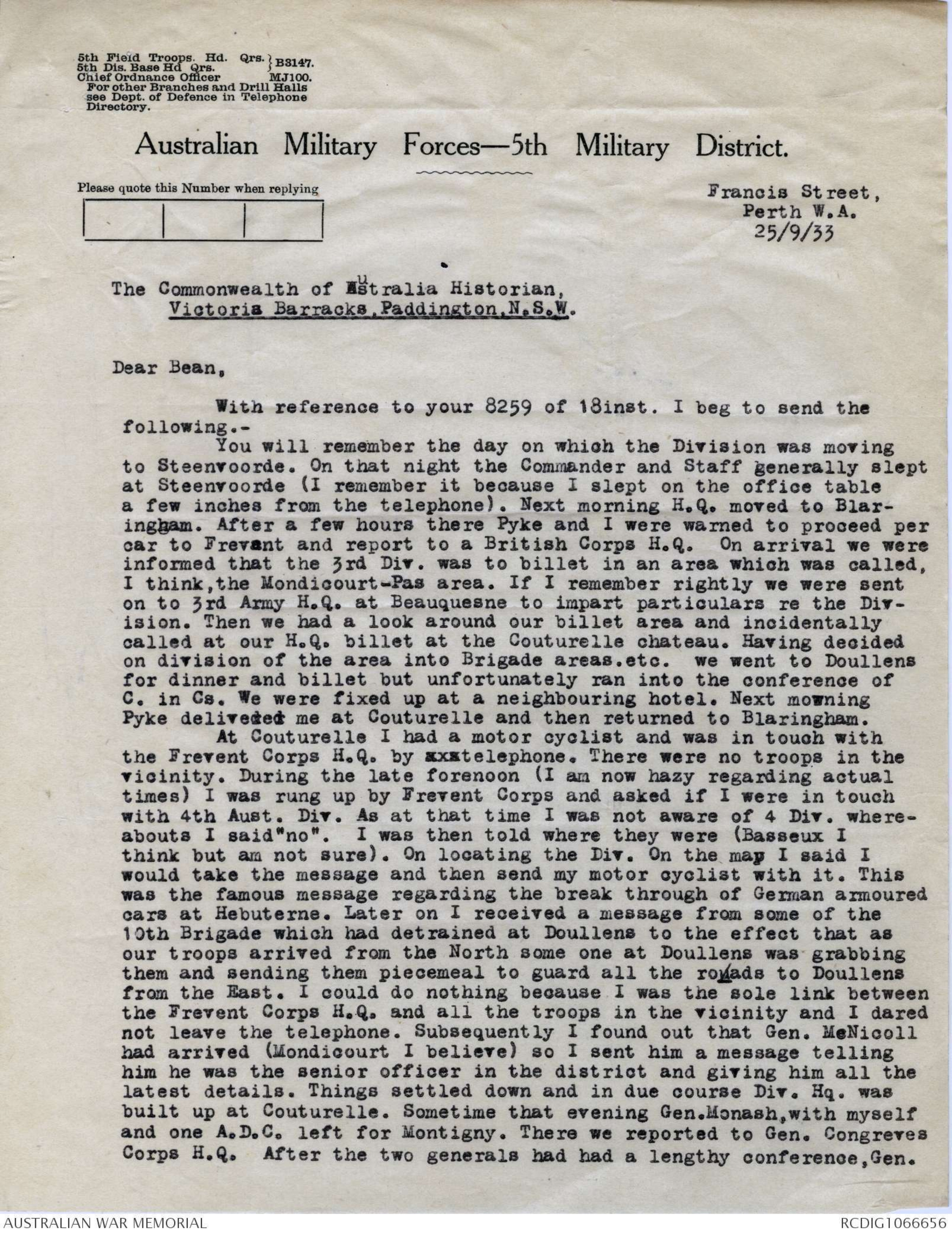
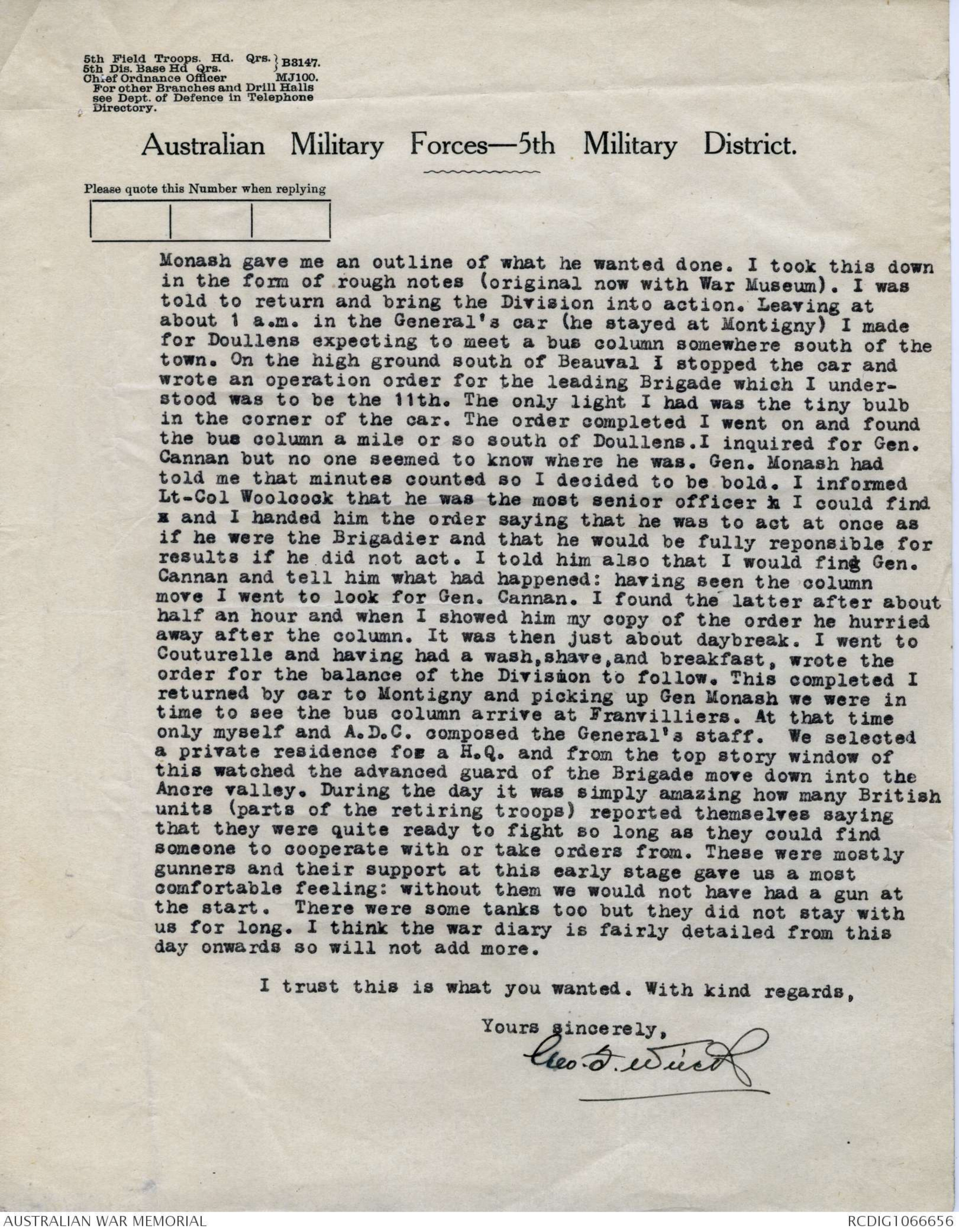
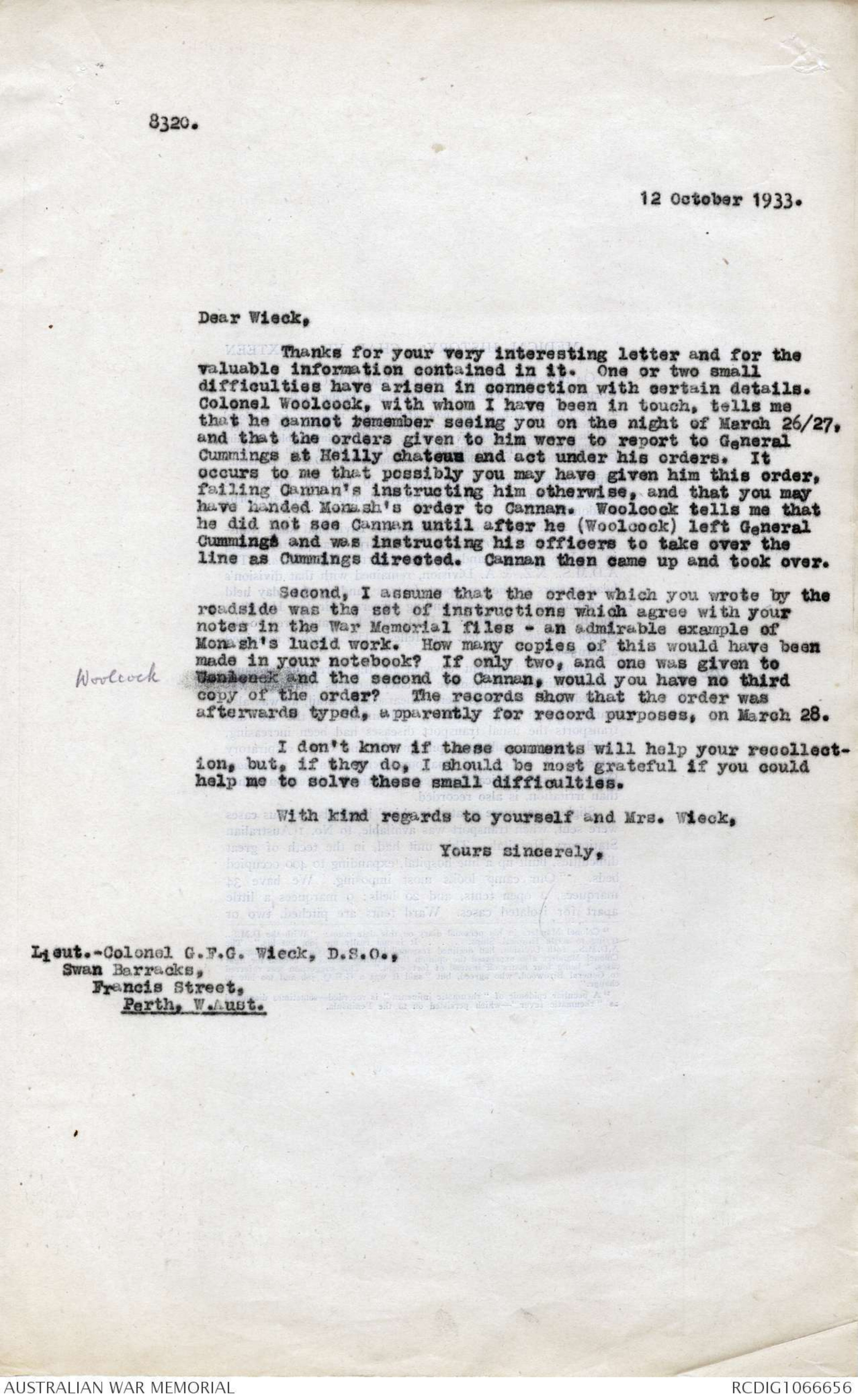

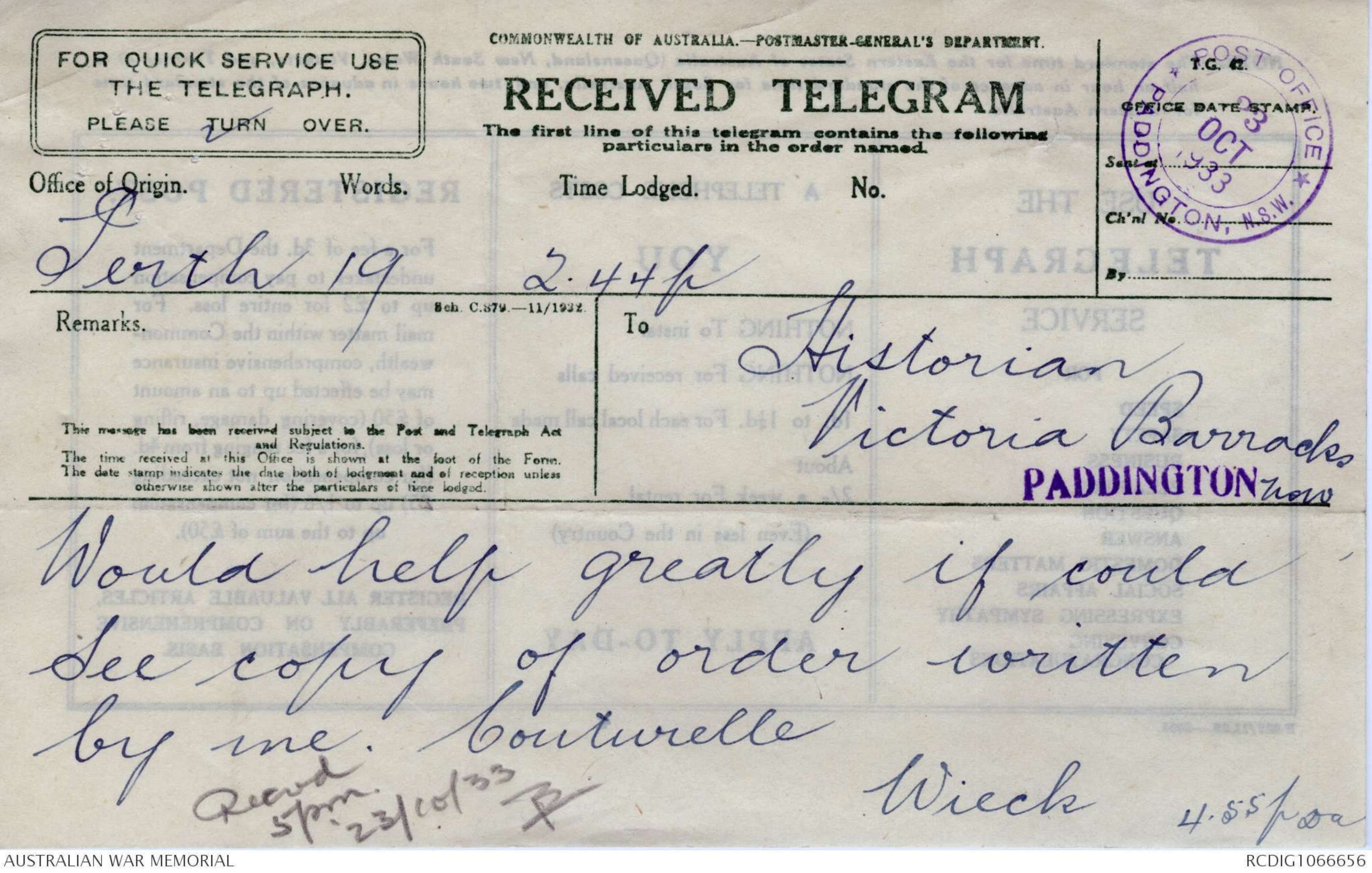
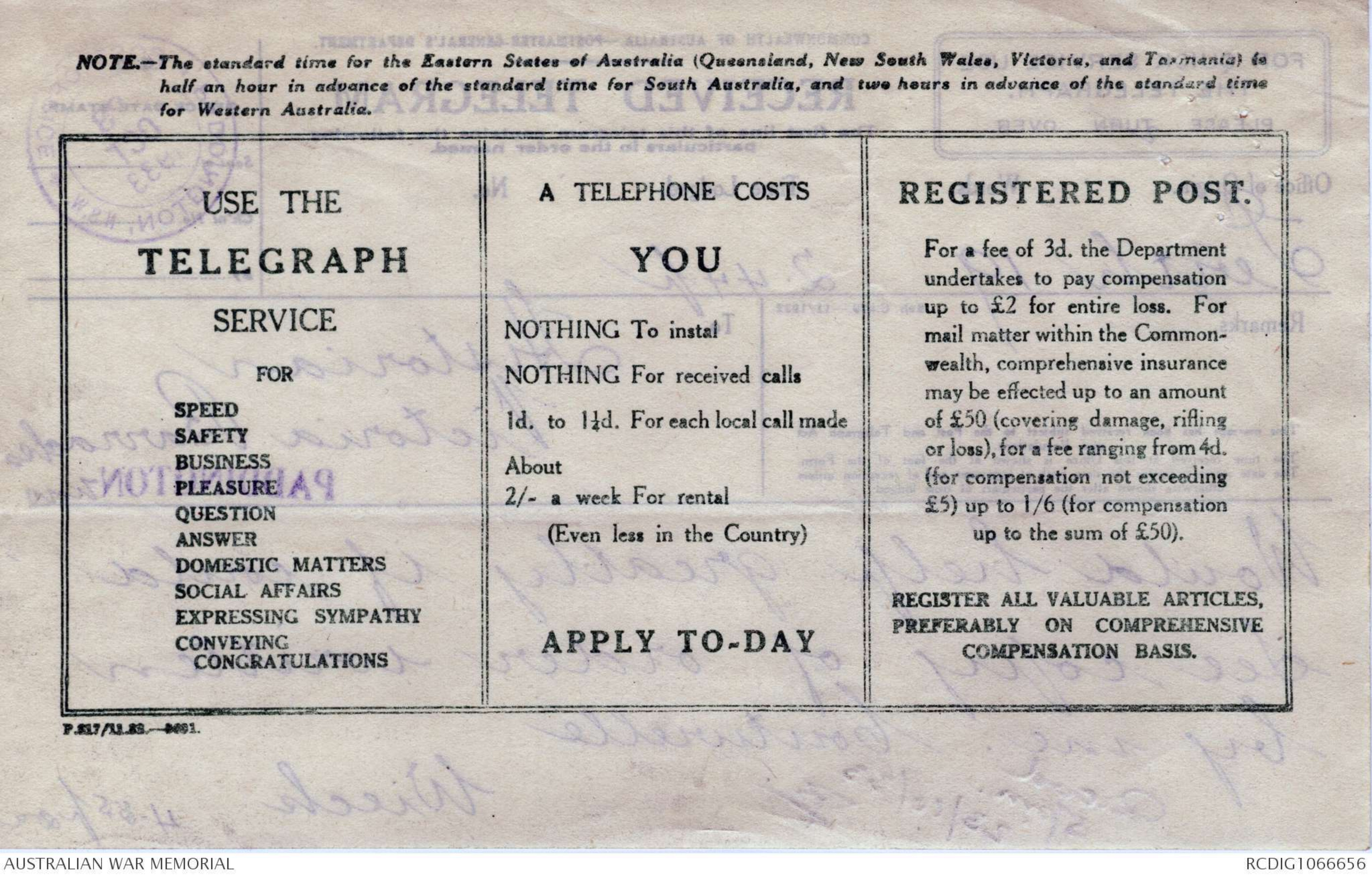
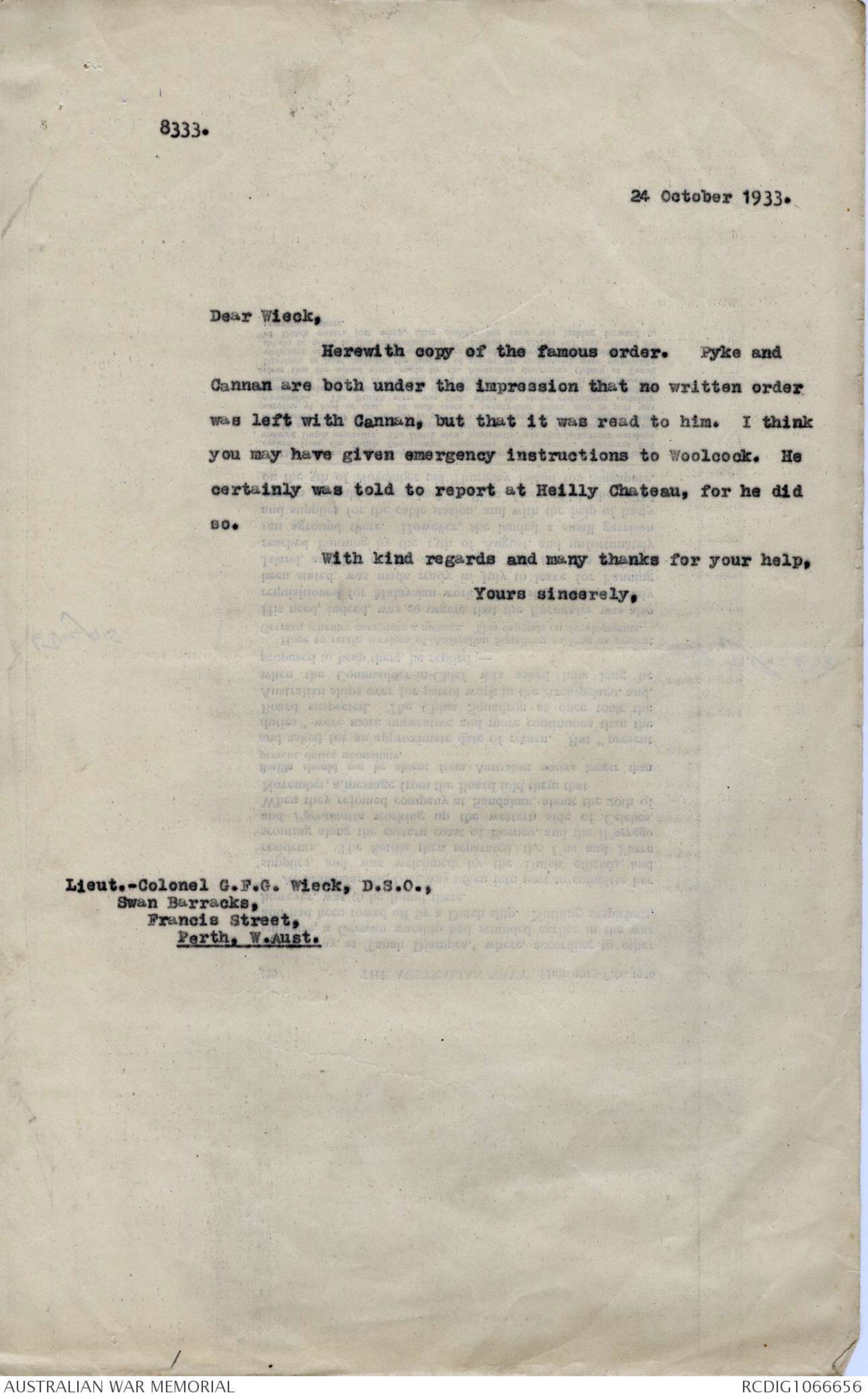
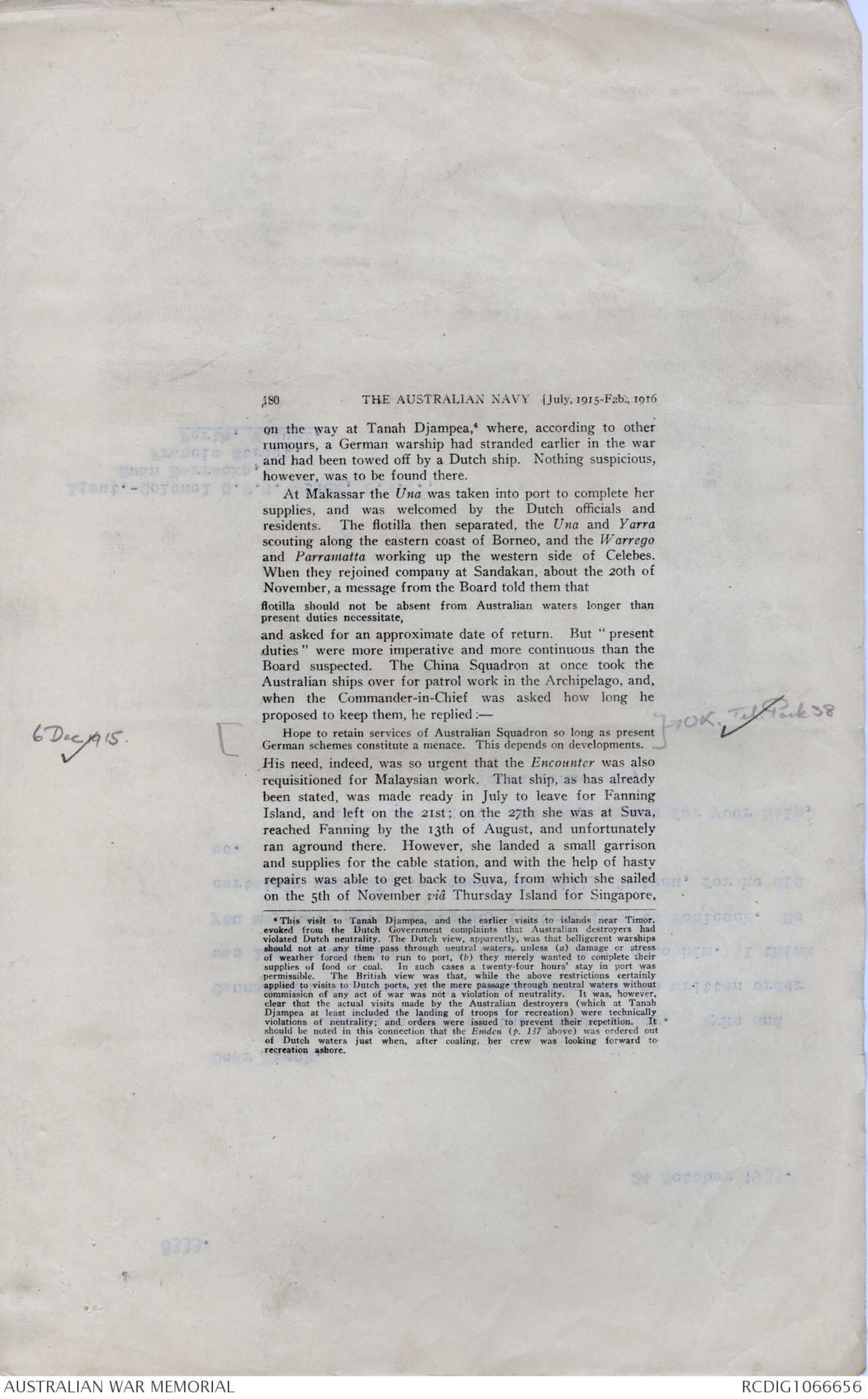


5th Field Troops. Hd. Qrs.) B3147
5th Dis. Base Hd Qrs.
Chief Ordnance Officer MJ100
For other Branches and Drill Halls
see Dept. of Defence in Telephone
Directory.
Australian Military Forces-5th Military District.
Please quote this Number when replying
Francis Street,
Perth W.A.
25/9/33
The Commonwealth of Australia Historian,
Victoria Barracks Paddington, N.S.W.
Dear Bean,
With reference to your 8259 of 18inst. I beg to send the
following.-
You will remember the day on which the Division was moving
to Steenvoorde. On that night the Commander and Staff generally slept
at Steenvoorde (I remember it because I slept on the office table
a few inches from the telephone). Next morning H.Q. moved to Blaringham.
After a few hours there Pyke and I were warned to proceed per
car to Frevant and report to a British Corps H.Q. On arrival we were
informed that the 3rd Div. was to billet in an area which was called,
I think, the Mondicourt-Pas area. If I remember rightly we were sent
on to 3rd Army H.Q. at Beauquesne to impart particulars re the Division.
Then we had a look around our billet area and incidentally
called at our H.Q. billet at the Couturelle chateau. Having decided
on division of the area into Brigade areas.etc. we went to Doullens
for dinner and billet but unfortunately ran into the conference of
C. in Cs. We were fixed up at a neighbouring hotel. Next mowning
Pyke delivered me at Couturelle and then returned to Blaringham.
At Couturelle I had a motor cyclist and was in touch with
the Frevent Corps H.Q. by xxxtelephone. There were no troops in the
vicinity. During the late forenoon (I am now hazy regarding actual
times) I was rung up by Frevent Corps and asked if I were in touch
with 4th Aust. Div. As at that time I was not aware of 4 Div. whereabouts
I said"no”. I was then told where they were (Basseux I
think but am not sure). On locating the Div. On the map I said I
would take the message and then send my motor cyclist with it. This
was the famous message regarding the break through of German armoured
cars at Hebuterne. Later on I received a message from some of the
10th Brigade which had detrained at Doullens to the effect that as
our troops arrived from the North some one at Doullens was grabbing
them and sending them piecemeal to guard all the rouads to Doullens
from the East. I could do nothing because I was the sole link between
the Frevent Corps H.Q. and all the troops in the vicinity and I dared
not leave the telephone. Subsequently I found out that Gen. McNicoll
had arrived (Mondicourt I believe) so I sent him a message telling
him he was the senior officer in the district and giving him all the
latest details. Things settled down and in due course Div. Hq. was
built up at Couturelle. Sometime that evening Gen. Monash, with myself
and one A.D.C. left for Montigny. There we reported to Gen. Congreves
Corps H.Q. After the two generals had had a lengthy conference, Gen.
5th Field Troops. Hd. Qrs.) B3147
5th Dis. Base Hd Qrs.
Chief Ordnance Officer MJ100
For other Branches and Drill Halls
see Dept. of Defence in Telephone
Directory.
Australian Military Forces-5th Military District.
Please quote this Number when replying
Monash gave me an outline of what he wanted done. I took this down
in the form of rough notes (original now with War Museum). I was
told to return and bring the Division into action. Leaving at
about 1 a.m. in the General's car (he stayed at Montigny) I made
for Doullens expecting to meet a bus column somewhere south of the
town. On the high ground south of Beauval I stopped the car and
wrote an operation order for the leading Brigade which I understood
was to be the 11th. The only light I had was the tiny bulb
in the corner of the car. The order completed I went on and found
the bus column a mile or so south of Doullens. I inquired for Gen.
Cannan but no one seemed to know where he was. Gen. Monash had
told me that minutes counted so I decided to be bold. I informed
Lt-Col Woolcock that he was the most senior officer x I could findx and I handed him the order saying that he was to act at once as
if he were the Brigadier and that he would be fully reponsible for
results if he did not act. I told him also that I would find Gen.
Cannan and tell him what had happened: having seen the column
move I went to look for Gen. Cannan. I found the latter after about
half an hour and when I showed him my copy of the order he hurried
away after the column. It was then just about daybreak. I went to
Couturelle and having had a wash, shave, and breakfast, wrote the
order for the balance of the Division to follow. This completed I
returned by car to Montigny and picking up Gen Monash we were in
time to see the bus column arrive at Franvilliers. At that time
only myself and A.D.C. composed the General's staff. We selected
a private residence for a H.Q. and from the top story window of
this watched the advanced guard of the Brigade move down into the
Ancre valley. During the day it was simply amazing how many British
units (parts of the retiring troops) reported themselves saying
that they were quite ready to fight so long as they could find
someone to cooperate with or take orders from. These were mostly
gunners and their support at this early stage gave us a most
comfortable feeling: without them we would not have had a gun at
the start. There were some tanks too but they did not stay with
us for long. I think the war diary is fairly detailed from this
day onwards so will not add more.
I trust this is what you wanted. With kind regards,
Yours sincerely,
Geo. F. Wieck
8320.
12 October 1933.
Dear Wieck,
Thanks for your very interesting letter and for the
valuable information contained in it. One or two small
difficulties have arisen in connection with certain details.
Colonel Woolcock, with whom I have been in touch, tells me
that he cannot remember seeing you on the night of March 26/27,
and that the orders given to him were to report to General
Cummings at Heilly chateau and act under his orders. It
occurs to me that possibly you may have given him this order,
failing Cannan's instructing him otherwise, and that you may
have handed Monash's order to Cannan. Woolcock tells me that
he did not see Cannan until after he (Woolcock) left General
Cummings and was instructing his officers to take over the
line as Cummings directed. Cannan then came up and took over.
Second, I assume that the order which you wrote by the
roadside was the set of instructions which agree with your
notes in the War Memorial files - an admirable example of
Monash's lucid work. How many copies of this would have been
made in your notebook? If only two, and one was given to
[*Woolcock*] Wenlenck and the second to Cannan, would you have no third
copy of the order? The records show that the order was
afterwards typed, apparently for record purposes, on March 28.
I don't know if these comments will help your recollection,
but, if they do, I should be most grateful if you could
help me to solve these small difficulties.
With kind regards to yourself and Mrs. Wieck,
Yours sincerely,
Lieut.-Colonel G.F.G. Wieck, D.S.O.,
Swan Barracks,
Francis Street,
Perth, W. Aust.
MEDICAL HISTORY. CHAP. VII. SIXTEEN
On the same day also the D.A. and Q.M.G. of the Anzac
Corps wrote to General Headquarters stating that
as the D.M.S., M.E.F., has now arrived, the necessity for Colonel
Manders to act in his stead no longer exists. As Colonel Manders
will have to accompany his Division, it will be impossible for him
to continue to carry out his duties of D.M.S. (sic) with the Army
Corps Headquarters in addition to his duties as A.D.M.S. Division.
This matter having been referred to General Birrell, he
instructed that in future all orders should be sent to corps
headquarters.13
On April 23rd the 1st Australian Divisional staff transferred
to H.M.S. Prince of Wales, corps headquarters being
in H.M.S Queen and the transport Minnewaska. The
A.D.M.S., N.Z. & A. Division, remained with that division's
headquarters in the transport Lützow, and on that day held
- a conference of his commanding officers. Sir lan Hamilton
and the General Staff of G.H.Q., M.E.F., transferred to the
Queen Elizabeth, and left for Helles. The Arcadian remained
[*dr /*]at Murddros.
During the fortnight covered by the foregoing account,
special training, as intensive as circumstances pernmitted, was
carried out. Landings were rehearsed in detail, as was also
tansfer from ships to tows. Meanwhile in the crowded
transports the usual transport diseases had been increasing,
chiefly measles, influenza, pneumonia, and other respiratory
infections.14 A case of smallpox occurred in the Arcadian.
Diarrhœa, with clinical features suggestive of infection rather
than irritation, is also recorded.
Slight cases were treated in ships' hospitals; serious cases
were sent, when transport was available, to No. 1 Australian
Stationary Hospital. This unit had, in the teeth of great
difficulties, built up a fine hospital, expanding to 400 occupied
beds. Our camp looks most imposing. We have 34
marquees, 2 open tents, and 20 bells; 9 marquees a little
apart for isolated cases. Ward tents are pitched, two or
13 Colonel Manders in his personal diary on this date notes: "With the D.M.S.,
trying to settle Hospital Ships...It is not really my job, but his." The
A.D.M.S., 29th Division, had declined responsibility in connection with transports.
Colonel Manders also expressed the opinion that Mudros should be a base for light
cases, "being four hours off instead of forty eight." This suggestion was referred
to General Birdwood, who agreed, but "said it was a G.H.Q. job and too late to
change"
14 A peculiar epidemic of "rheumatic influenza" is recorded--sometimes diagnosed
as "rheumatic fever"–which persisted on to the Peninsula.
COMMONWEALTH OF AUSTRALIA - POSTMASTER-GENERAL'S DEPARTMENT
POST OFFICE
23 OCT 1933
PADDINGTON, N.S.W.
Tenth 19 2.44p
To
Historian
Victoria Barracks
PADDINGTON now
Would help greatly if could
see copy of order written
by me. Courturelle
Wieck 4.55pm
Recvd
5pm
23/10/33 B.
8333.
24 October 1933.
Dear Wieck,
Herewith copy of the famous order. Pyke and
Cannan are both under the impression that no written order
was left with Cannan, but that it was read to him. I think
you may have given emergency instructions to Woolcock. He
certainly was told to report at Heilly Chateau, for he did
so.
With kind regards and many thanks for your help,
Yours sincerely,
Lieut.-Colonel G.F.G. Wieck, D.S.O.,
Swan Barracks,
Francis Street,
Perth, W.Aust.
180 THE AUSTRALIAN NAVY [July, 1915-Feb.,1916
on the way at Tanah Djampea,4 where, according to other
rumours, a German warship had stranded earlier in the war
and had been towed off by a Dutch ship. Nothing suspicious,
however, was to be found there.
At Makassar the Una was taken into port to complete her
supplies, and was welcomed by the Dutch officials and
residents. The flotilla then separated, the Una and Yarra
scouting along the eastern coast of Borneo, and the Warrego
and Parramatta working up the western side of Celebes.
When they rejoined company at Sandakan, about the 20th of
November, a message from the Board told them that
flotilla should not be absent from Australian waters longer than
present duties necessitate,
and asked for an approximate date of return. But "present
duties" were more imperative and more continuous than the
Board suspected. The China Squadron at once took the
Australian ships over for patrol work in the Archipelago, and,
when the Commander-in-Chief was asked how long he
proposed to keep them, he replied:-
[*6 Dec 1915 🗸*] Hope to retain services of Australian Squadron so long as present [*OK. Tel. Pack 38 🗸*]
German schemes constitute a menace. This depends on developments.
His need, indeed, was so urgent that the Encounter was also
requisitioned for Malaysian work. That ship, as has already
been stated, was made ready in July to leave for Fanning
Island, and left on the 21st; on the 27th she was at Suva,
reached Fanning by the 13th of August, and unfortunately
ran aground there. However, she landed a small garrison
and supplies for the cable station, and with the help of hasty
repairs was able to get back to Suva, from which she sailed
on the 5th of November viâ Thursday Island for Singapore,
4 This visit to Tanah Djampea, and the earlier visits to islands near Timor,
evoked from the Dutch Government complaints that Australian destroyers had
violated Duich neutrality. The Dutch view, apparently, was that belligerent warships
should not at any time pass through neutral waters, unless (a) damage or stress
of weather forced then to run to port, (b) they merely wanted to complete their
supplies of food or coal. In such cases a twenty-four hours' stay in port was
permissible. The British view was that, while the above restrictions certainly
applied to visits to Dutch ports, yet the mere passage through neutral waters without
commission of any act of war was not a violation of neutrality. It was, however,
clear that the actual visits made by the Australian destroyers (which at Tanah
Djampea at least included the landing of troops for recreation) were technically
violations of neutrality; and orders were issued to prevent their repetition. It
should be noted in this connection that the Emden (p. 137 above) was ordered out
of Dutch waters just when, after coaling, her crew was looking forward to
recreation ashore.
Copy - 28/3/18 - PWP
THIRD AUSTRALIAN DIVISION
Divisional Headquarters,
27th March 1918.
INSTRUCTIONS IN CONNECTION WITH THE MOVE OF THE
DIVISION TO THS FRANVILLERS SECTOR.
SITUATION. On the morning of the 26th March the line ran ALBERT-BRAY.
Orders were to hold the line but to retire in the face of a serious
attack.
At 4-0 p.m. 26th orders were issued to hold the line at all
costs. Orders could not be got to the troops in time, and the line was
withdrawn to ALBERT and some point West of BRAY. The situation on this
line is much confused and the position South of the SOMME is obscure.
ORDERS RECEIVED: Orders have been received by the Division to hold a
line of wire and trench roughly conforming to the MERICOURT-SAILLY-le-
Sec Road with both x flanks on the rivers - i.e., ANCRE and SOMME.
To-night 26/27th, this line is being held by about 2,000 mixed infantry.
ACTION TO BE TAKEN: The Divisional Commander has decided that one
Brigade will hold thisline south of the CORBIE-BRAY Road, and one
Brigade to the North of it.
The Brigade in reserve will be at Heilly. D.H.Q., Pioneer Bn.,
and Div. Machine Gun Company at Franvillers.
Divisional Artillery to move to BEHENCOURT.
HOW LINE TO BE OCCUPIED: The Battalions of the 11th Brigade will debus
at cross-roads south of FRANVILLERS.
The first battalion will cross the river at HEILLY and move by
the cart-track across the spur and occupy the line south of the CORBIE-BRAY
Road.
The second battalion will move up the gully near MERICOURT and
occupy the line north of the CORBIE-BRAY Road.
The River Valley will be actually held and not merely covered,
and the position will be organised in depth.
The third battalion will be held in support of the right wing.
Brig.-General Cannan will command all troops in the sector and
will not allow any to leave until D.H.Q. consents.
READJUSTMENT: On the arrival of the 10th Brigade it will at once take
over the line north of the CORBIE-BRAY Road, and the 11th Brigade
battalion will be moved to its own brigade area.
GENERAL: All bridges over the SOMME east of BRAY have been destroyed;
those further west have been prepared for demolition and will be blown
up if the enemy advances.
South of the Somme the position of the left flank of the
FIFTH ARMY is obscure, but it is said to be south of BRAY.
NORTH OF THE ANCRE: The 39th Division hold the line - H.Q. at Lavieville
LAIEVIELLE. The 4th Australian Division has two brigades near BRESLE.
H.Q. at BAIZIEUX.
ENEMY METHODS: The Boche attacks up valley and hollows and is quick at
finding a gap. He gets his M.G's forward and uses them in enfilade.
His infantry wait at 600 yards for the M.G's to get to work.
The next 48 hours are regarded as critical.
ARTILLERY: There is practically no artillery directly covering our
line, but we may have many guns slightly further north, and they can give
some help.
The enemy has not many guns.
Our Vickers guns should be mainly on the RIGHT.
MAPS: No 1/40,000 available.
S.A.A.: Sub-Park to carry as much S.A.A. as possible, and to move to the
new area quickly.
2.
TRANSPORT AND PACKS: Transport should be sent down as early as
possible.
D.H.Q. Divisional Headquarters will close at COUTERELLE at 8-0 a.m.
and will move to FRANVILLERS.
(sgd) Geo. F. WIECK,
Major
for Lieut.-Colonel G.S.
 Sam scott
Sam scottThis transcription item is now locked to you for editing. To release the lock either Save your changes or Cancel.
This lock will be automatically released after 60 minutes of inactivity.